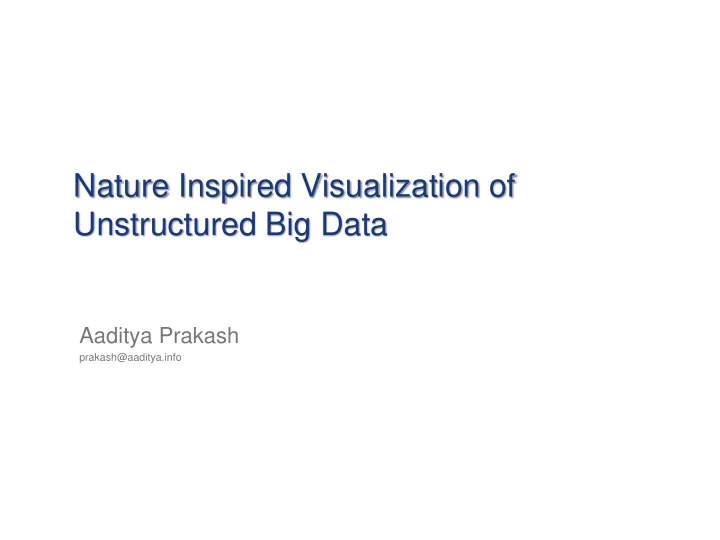

Nature Inspired Visualization of Unstructured Big Data Aaditya Prakash prakash@aaditya.info
Motivation • Unstructured data is ubiquitous and is assumed to be around 80% of all data generated 1 • Lack of recognizable structure and huge size makes it very challenging to work with Unstructured Large Datasets • Classical Visualization – not suited for BigData; slow, memory hogging, limited dimensions Self Organizing Maps • Unsupervised Machine Learning Technique • Provides dimension reduction • Multivariate Analysis • Fast and low on memory (2D planar images) • Reconstructing Self Organizing Maps as Spider Graphs for better visual interpretation 1 Unstructured Data and the 80 Percent Rule, Clarabridge Bridgepoints, 2008 Q3. http://clarabridge.com/default.aspx?tabid=137&ModuleID=635&ArticleID=551
Self Organizing Maps • Artificial Neural Networks proposed by Teuvo Kohonen 1 which transforms the input dataset into two dimensional lattice • Points in input layer are mapped onto 2D lattice, making each point potentially a Neuron Figure: Discriminant Function where, x = point on Input Layer w = weight of the input point (x) i = all the input points j = all the neurons on the lattice d = Euclidean distance Figure: Kohonen Network 1 Kohonen, T.; "The self-organizing map," Proceedings of the IEEE , vol.78, no.9 http://ieeexplore.ieee.org/stamp/stamp.jsp?tp=&arnumber=58325&isnumber=21
Current Visualization of SOM Fig: ‘R’, package Fig: ‘R’, package Fig: RapidMiner ‘Kohonen’ ‘SOM’ Tool (AGPL) Shows the Kohonen Intervariate plot of 4 Regression of the same Map obtained after frequent words in four words training the Neurons Spam
Algorithm 1. Filter the results 2. Make a polygon with as many sides as the variables. 3. Make the radius of the polygon to be the maximum of the value in the dataset. 4. Draw the grid for the polygon 5. Make segments inside the polygon if the strength of the two variables inside the segment is greater than the specified threshold. 6. Loop Step 5 for every variable against every other variable 7. Color the segments based on the frequency of variable. 8. Color the line segments based on the threshold of each variable pair plotted.
Spider Plots SOM visualization in R using the SOM visualization in R using Algorithm given above. (showing Algorithm given above (showing segments i.e inter-variable threads, i.e inter-variable strength) dependency)
Big picture for Big Data
Conclusion • Analyze inter-variate relations • No need to convert Unstructured to Structured Data • Advantages of Machine Learning and Visualization in single step • Discover hidden relationships and potentially mining oppurtunities Scope • Enhance to work with images, sound and videos • Dynamic representation to show live changes
References • Kohonen, T.; "The self-organizing map," Proceedings of the IEEE , vol.78, no.9, pp.1464-1480, Sep 1990 • Teuvo Kohonen, Panu Somervuo, How to make large self-organizing maps for nonvectorial data, Neural Networks, Volume 15, Issues 8 – 9, October – November 2002 • Gail A. Carpenter, Stephen Grossberg, A massively parallel architecture for a self- organizing neural pattern recognition machine, Computer Vision, Graphics, and Image Processing, Volume 37, Issue 1, January 1987, Pages 54-115 • R. Wehrens and L.M.C. Buydens, Self- and Super-organising Maps in R: the kohonen package J. Stat. Softw., 21(5), 2007 • Jun Yan, Self-Organizing Map (with application in gene clustering) in R • Gordon V. Cormack. 2008. Email Spam Filtering: A Systematic Review. Found. Trends Inf. Retr. 1, 4 (April 2008) • Anurat Chapanond, Mukkai S. Krishnamoorthy, and B\&\#252;lent Yener. 2005. Graph Theoretic and Spectral Analysis of Enron Email
Recommend
More recommend